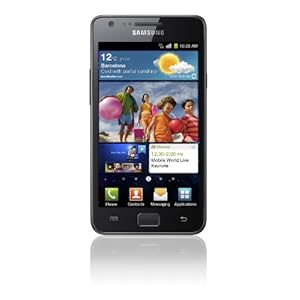Introduction
You don't see many of those around. Perhaps you're looking in the wrong place. As always, we're glad to be of service but, no, the Samsung i7410 didn’t ring any bells. It was the good old Phone Finder again. Anyway, this is how it started - if you'll excuse our hazy knowledge of the Asian market. The first projector phone was a dumbphone, but the whole thing wasn't such a dumb idea after all.
There was obviously potential waiting to be unleashed and no one could've done that better than Android. Now, wind back to 2010 and the first projector smartphone. And by the way, the Samsung I8520 Galaxy Beam was not just another smartphone - 3.7" AMOLED was quite the business back then. Not to mention the 8MP stills and 720P video.

But enough history. Here's what the new Galaxy Beam is all about.
Samsung I8530 Galaxy Beam at a glance:
- Built-in 15-lumen nHD projector
- General: GSM 850/900/1800/1900 MHz, 3G with HSPDA 14.4 Mbps, HSUPA 5.76 Mbps
- Form factor: Touchscreen bar phone
- Dimensions: 124 x 64.2 x 12.5 mm, 145.3g
- Display: 4.0" 16M-color TFT capacitive touchscreen, 480 x 800 pixels
- CPU: Dual-core 1GHz ARM Cortex-A9 processor, Mali-400 GPU
- Memory: 768 MB RAM, 8GB storage, microSD card slot
- OS: Android OS, v2.3.6 Gingerbread with TouchWiz 4.0
- Camera: 5 megapixel auto-focus camera with LED flash; face detection, geo-tagging; 1.3MP front-facing camera
- Video recording: 720p video recording
- Connectivity: Wi-Fi b/g/n, Bluetooth 3.0 with A2DP, standard microUSB port, GPS receiver with A-GPS, 3.5mm audio jack
- Battery: 2,000 mAh
- Misc: Accelerometer, proximity sensor, Swype text input, Polaris Office document viewer/editor
Now, we don’t need to tell you the original Galaxy Beam didn’t quite catch on. OK, a projector phone is not something you can expect to make huge money off. But it's not an idea either that you just throw in the bin.
So, Samsung's decision to stick with their plan gives us the I8530 Galaxy Beam. Given the original projector phone barely made an appearance outside the MWC venue, this is not what you'd call a grand return.
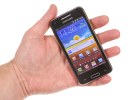
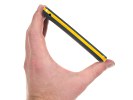
The Samsung Galaxy Beam at HQIt's a measured and cautious second try and we don't think Samsung can be blamed for playing it too safe. The truth is the new Galaxy Beam is actually a step down from what the original offered two years ago. AMOLED has been swapped for LCD, the inbuilt storage cut in half, the 8MP camera relegated to 5MP and the WVGA pico projector reduced to nHD.
Of course, the bump in processing power is welcome. The new Beam has a dual-core engine and double the RAM. The projector makes up for the lost resolution with increased brightness - 15 lumens, up from the original 10.
Ultimately, it wasn't Samsung's goal to upgrade the original. They wanted something doable instead, a sensible projector/smartphone combo and, not least, more affordable. It will take a full review to see if the I8530 Galaxy Beam is up to it. But this quick preview of an early pre-production unit should give us a good idea of what to expect.
Samsung I8530 Galaxy Beam 360-degree spin
The I8530 Samsung Galaxy Beam is genuinely trying to improve on the ergonomics its predecessor. Not that you should expect a phone with a built-in projector to be ultra compact. At 124 x 64.2 x 12.5 the new Beam is a slightly taller device but a good 2.4 mm slimmer and it's also more than 10g lighter.
The I8530 Galaxy Beam has a bigger screen than the original but while the resolution stays the same it's a garden variety LCD and not a Super AMOLED.
Design and build quality
Place the Galaxy Beam down on a table and you'll hardly be able to tell it apart from a Samsung Galaxy R or an S Advance. The actual difference is in screen size and technology. The Beam comes with a regular 4" LCD screen. The S Advance has a 4" Super AMOLED, while the Galaxy R is equipped with a 4.2" SuperClear LCD.
The WVGA (480 x 800) resolution works out to a pixel density of around 233 ppi. It's a decent display but nothing to write home about. Colors are slightly dull and the screen could've been brighter overall. It still does better in terms of sunlight legibility than we expected and its viewing angles are quite respectable too.


The Galaxy Beam frontThere's a secondary camera above the display, as well as proximity and ambient light sensors. Moving below the display you'll find the usual Home button flanked by two capacitive controls: Menu and Back.


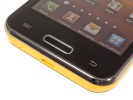
Above and below the displayThe projector lens is placed at the top, deeply inset under a big piece of protective glass. It stays out of the way most of the time and only slightly protrudes at the back.
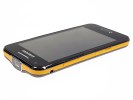
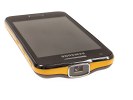
The top of the Galaxy BeamMore than once during our test, it felt the lens would've made sense on one of the sides of the smartphone, given the projector's default orientation is landscape but more on that later.
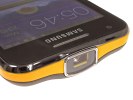
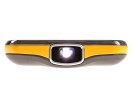
The projector lensThe projector can be used a flashlight as well, and it's quite suited to that job too, if you don't mind the relatively small lit surface.Its placement certainly feels more natural than a LED on the back.
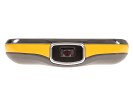
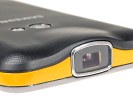
The projector doubles as a flashlightOn the right side of the handset, closest to the top, is the dedicated projector key. A little further down is the usual power/lock button. We did mix those two up at first, hitting the projector button instead of the unlock button. However, it doesn't take too long to get used to the arrangement. The last thing to note on the right is a hot-swappable microSD card slot hidden under a small lid.
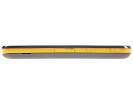
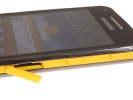
On the right of the phoneThe volume rocker is on the left side, where we were surprised to find an external SIM slot as well. It's quite out of the ordinary for the SIM compartment to be placed on the outside but the phone's inner body is almost entirely sealed. It's actually bolted to the front, making the smartphone more dust-resistant than usual.
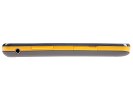
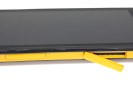
The left side of the Galaxy BeamThe bottom of the Galaxy Beam features the mouthpiece and a microUSB port for charging and data connections.
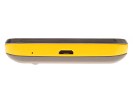
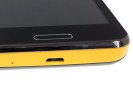
The bottomThe back panel of the Galaxy Beam is entirely made of plastic but benefits from a nice anti-slip rubbery finish. There's a slight bulge at the top to accommodate the projector. The 5 MP camera lens is centrally placed right below that buldge, with a single LED flash at its side.
In the bottom left corner is the loudspeaker grille.
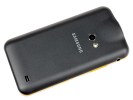
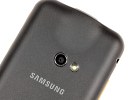
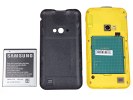
The rubberized back panel and under the hoodRemoving the back panel reveals the 2,000 mAh Li-Ion battery. We didn't have time to do a detailed test, which wouldn't have been too revealing anyway - our test unit is still in the early stages of its development. It's worth noting though, that Samsung promise around 3 hours of projection time. We'll make sure to test that out when we hopefully get a retail unit, but you'll probably be able to count on above average power backup , whether or not the phone is used as an actual projector.


The Samsung Galaxy Beam in handThe Samsung Galaxy Beam is not the slimmest phone out there, not by a long shot, but it's extremely well put together and reasonably ergonomic. It's comfortable and secure to hold, and fairly easy to operate with one hand. It seems though that a stable stand will be most welcome in projector mode, if the presentation requires using the screen.
The actual projector performance is coming up right after the break.











 When you want to buy cellular phones Samsung Galaxy Nexus 4Gis your right choice. This popular cell phone is the first smart phone introduced with Android and now it has come back with new user interface and new features. This phone has the dual processor with 1.2 GHz power that has good speed while playing games. The display screen has a 4.65 inch HD Super AMOLED Contour Display. The internal memory power is 32 GB RAM.One of the popular cell phones is Samsung Galaxy Nexus 4G due to its rich multimedia features. This phone is connected with the Verizon Wireless 4G LTE Mobile Broadband Network. This 4G facility allows the customer to browse the internet, send and receive email, enjoy music, watch movies and share important data. The download speed of the data is 5 to 12 (mbps) and upload speed is 2 to 5 mbps. Sharing with other devices is very much easy in this Android phone. The customer can share this phone with their laptop, MP3 Player and with another phone.
When you want to buy cellular phones Samsung Galaxy Nexus 4Gis your right choice. This popular cell phone is the first smart phone introduced with Android and now it has come back with new user interface and new features. This phone has the dual processor with 1.2 GHz power that has good speed while playing games. The display screen has a 4.65 inch HD Super AMOLED Contour Display. The internal memory power is 32 GB RAM.One of the popular cell phones is Samsung Galaxy Nexus 4G due to its rich multimedia features. This phone is connected with the Verizon Wireless 4G LTE Mobile Broadband Network. This 4G facility allows the customer to browse the internet, send and receive email, enjoy music, watch movies and share important data. The download speed of the data is 5 to 12 (mbps) and upload speed is 2 to 5 mbps. Sharing with other devices is very much easy in this Android phone. The customer can share this phone with their laptop, MP3 Player and with another phone. 




